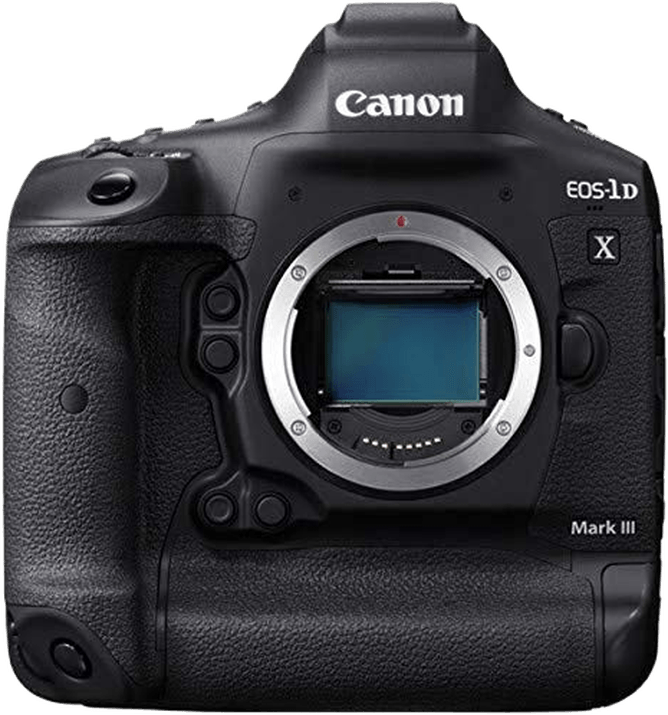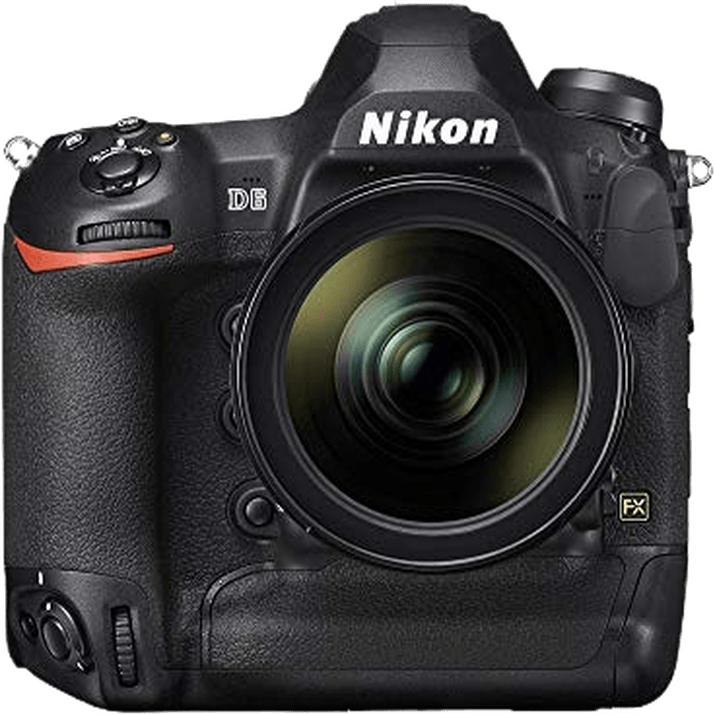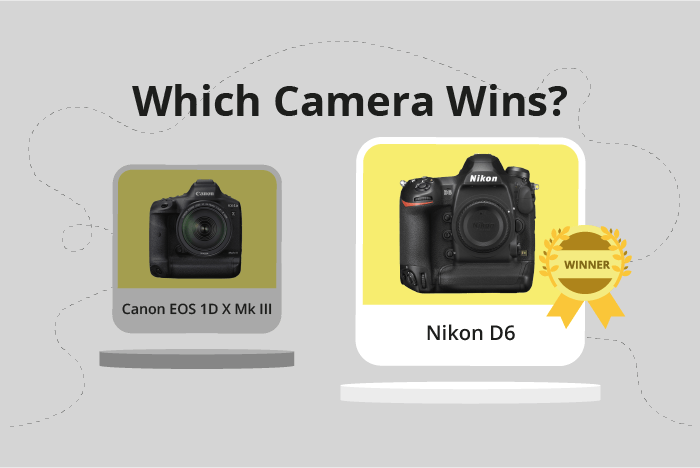Canon EOS 1D X Mark III vs Nikon D6 Comparison
Canon EOS 1D X Mark III

Nikon D6

The Nikon D6 edges out the Canon EOS 1D X Mark III with a score of 80/100 compared to 75/100. Both cameras are DSLRs released in 2020 and share the same launch price of $6500. They also have similar dimensions, with the Canon measuring 158 x 168 x 83mm and the Nikon at 160 x 163 x 92mm.
The Canon EOS 1D X Mark III has a lighter weight of 738g, making it more portable than the Nikon D6, which weighs 1450g. This can be an advantage for photographers who need to carry their gear for extended periods.
On the other hand, the Nikon D6’s higher score reflects its better performance in certain areas. This may include features such as autofocus, image quality, or usability, which are crucial for professional photographers.
Taking these factors into account, the Nikon D6 takes the lead as a more advanced camera, while the Canon EOS 1D X Mark III offers advantages in portability. Each photographer’s preferences and needs will ultimately determine the best choice for them.
Canon EOS 1D X Mark III vs Nikon D6 Overview and Optics
The Nikon D6 slightly outperforms the Canon EOS 1D X Mark III in optics, with a score of 75/100 compared to Canon’s 74/100. Both cameras share several common specifications, including a CMOS sensor, full-frame sensor size, and no image stabilization. They also have lens mounts specific to their respective brands: Canon EF for the 1D X Mark III and Nikon F for the D6.
The Nikon D6 excels with its higher megapixel count of 20.8 and a DXOMARK sensor score of 97, indicating better image quality. Additionally, the D6 is equipped with Nikon’s Expeed 6 processor, contributing to its overall performance. The Canon EOS 1D X Mark III, on the other hand, has a slightly lower megapixel count of 20.1 and a DXOMARK sensor score of 91.
However, the Canon EOS 1D X Mark III outshines the Nikon D6 in shooting speed, with 20 frames per second compared to the D6’s 14 frames per second. This advantage makes the Canon camera more suitable for capturing fast-moving subjects and action photography. The 1D X Mark III also features Canon’s Digic X processor, ensuring efficient processing and performance.
Despite the Nikon D6’s marginally better optics score, both cameras have their strengths and cater to different photography needs. The D6 offers superior image quality, while the Canon EOS 1D X Mark III provides a faster shooting speed. Ultimately, photographers should consider their specific requirements when choosing between these two high-performing cameras.
Canon EOS 1D X Mark III vs Nikon D6 Video Performance
The Canon EOS 1D X Mark III emerges as the winner in terms of video capabilities, scoring 91/100 against the Nikon D6, which scores 83/100. Both cameras share some common specifications, such as 4K video resolution and built-in time-lapse functionality. However, the Canon 1D X Mark III outperforms the Nikon D6 in certain aspects, making it the superior choice for video recording.
The Canon 1D X Mark III boasts a higher maximum video dimension of 4096 x 2160, compared to the Nikon D6’s 3840 x 2160. This difference in video dimensions allows the Canon camera to produce sharper and more detailed video footage. Additionally, the Canon 1D X Mark III offers a higher maximum video frame rate of 120fps, double that of the Nikon D6’s 60fps. This higher frame rate enables the Canon camera to capture smoother slow-motion videos and more versatile footage.
On the other hand, the Nikon D6 still delivers solid video performance despite its lower score. With 4K resolution and built-in time-lapse functionality, the Nikon D6 can produce high-quality videos for various purposes. However, its lower maximum video dimensions and frame rate make it less competitive than the Canon 1D X Mark III.
Considering the differences in video capabilities, the Canon EOS 1D X Mark III is the better choice for those prioritizing video recording quality and versatility. Its higher maximum video dimensions and frame rate provide an advantage over the Nikon D6. While the Nikon D6 remains a capable camera for video recording, the Canon 1D X Mark III’s superior video performance justifies its higher score.
Canon EOS 1D X Mark III vs Nikon D6 Features and Benefits
The Nikon D6 outperforms the Canon EOS 1D X Mark III in features, scoring 87/100 compared to the Canon’s 74/100. Both cameras share some specifications, such as a 3.2-inch screen size, touchscreen capability, GPS, and WIFI connectivity. However, the Nikon D6 surpasses the Canon EOS 1D X Mark III in several aspects.
The Nikon D6 has a higher screen resolution, with 2,359,000 dots compared to the Canon’s 2,100,000 dots. This higher resolution offers greater image clarity and detail when reviewing photos on the camera. The Canon EOS 1D X Mark III lacks this feature. The Nikon D6 also includes Bluetooth connectivity, which the Canon does not have, allowing for seamless and quick image transfers to compatible devices.
The Canon EOS 1D X Mark III does not surpass the Nikon D6 in any of the listed features, making it the less versatile option in terms of camera features. The Nikon D6’s higher feature score reflects its superiority in this area.
Given these differences, the Nikon D6 emerges as the better choice for photographers who prioritize advanced features and versatility in their camera. The Canon EOS 1D X Mark III, while still offering solid functionality, falls short in comparison to the Nikon D6’s superior feature set.
Canon EOS 1D X Mark III vs Nikon D6 Storage and Battery
The Nikon D6 outperforms the Canon EOS 1D X Mark III in storage and battery with a perfect score of 100/100, compared to the Canon’s 87/100. Both cameras share some common specifications, such as having two memory card slots. However, the Nikon D6 has an edge with its compatibility with both CFexpress and XQD memory cards, while the Canon only accepts CFexpress Type B cards.
Another advantage of the Nikon D6 is its longer battery life, providing 3580 shots compared to the Canon’s 2850 shots. Additionally, the Nikon D6 offers USB charging, which the Canon lacks. These features contribute to the Nikon D6’s higher score in storage and battery.
The Canon EOS 1D X Mark III does not have any clear advantage in this category. With fewer memory card options, shorter battery life, and no USB charging, it falls behind the Nikon D6 in terms of storage and battery performance.
In this comparison, the Nikon D6 emerges as the superior camera for storage and battery capabilities, offering more memory card options, extended battery life, and the convenience of USB charging. The Canon EOS 1D X Mark III falls short in this category, making the Nikon D6 a better choice for those prioritizing storage and battery performance.
Canon EOS 1D X Mark III vs Nikon D6 – Our Verdict
Are you still undecided about which camera is right for you? Have a look at these popular comparisons that feature the Canon EOS 1D X Mark III or the Nikon D6:

